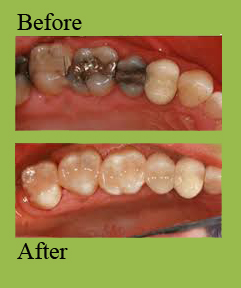 For many years, when you had a cavity, your dentist would remove the decay and place a silver filling material called “amalgam” to repair the tooth. Today, with new understanding and advancement of dental materials, dentists and patients have many more options for filling materials. Composite fillings or “bonding” has become a great option for almost every situation where a dental filling is needed. They esthetically pleasing since they mimic the color of a natural tooth, and when they are bonded into place they show remarkable strength characteristics.
For many years, when you had a cavity, your dentist would remove the decay and place a silver filling material called “amalgam” to repair the tooth. Today, with new understanding and advancement of dental materials, dentists and patients have many more options for filling materials. Composite fillings or “bonding” has become a great option for almost every situation where a dental filling is needed. They esthetically pleasing since they mimic the color of a natural tooth, and when they are bonded into place they show remarkable strength characteristics.
For example, bonding can be used to fill cavities on back molars instead of the well-known dark silver material. This looks more natural and conserves tooth structure since they are chemically bonded into place. Dentists have to remove more tooth structure to place traditional silver fillings. Bonding can also fix broken, chipped and worn down front incisor teeth, and can even be used for cosmetic purposes such as filling in gaps or changing the shape of your front teeth
What patients should know before having composite bonding done is that once the material is bonded to the tooth, it will not get any lighter in color with bleaching methods such as in-office or at-home bleaching. So if you plan on whitening your teeth, we suggest that you whiten them to the shade desired before we do any bonding, so that we can assure a good color match. Also, smoking cigarettes and drinking coffee and tea can also darken and stain the composite material. If you have any questions about bonding or composite restorations or teeth whitening, please talk to your Aspen Creek dentists to hear about the different services we offer.
Dr Zach Richardson
